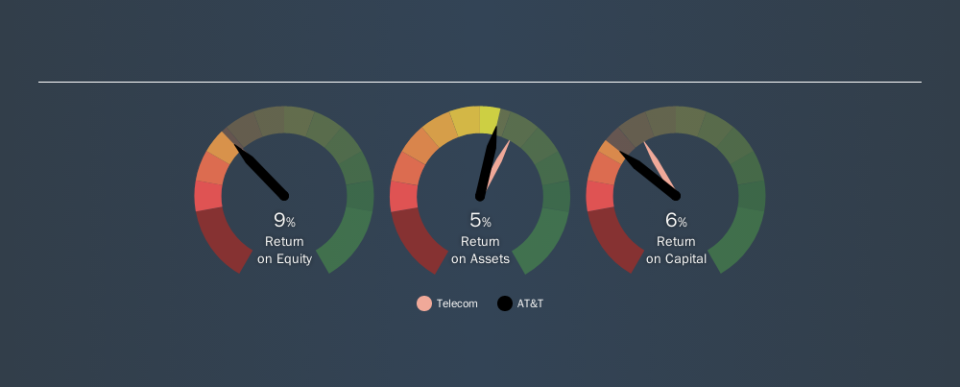Is AT&T Inc. (NYSE:T) Creating Value For Shareholders?

Today we'll evaluate AT&T Inc. (NYSE:T) to determine whether it could have potential as an investment idea. In particular, we'll consider its Return On Capital Employed (ROCE), as that can give us insight into how profitably the company is able to employ capital in its business.
First up, we'll look at what ROCE is and how we calculate it. Next, we'll compare it to others in its industry. Last but not least, we'll look at what impact its current liabilities have on its ROCE.
What is Return On Capital Employed (ROCE)?
ROCE is a measure of a company's yearly pre-tax profit (its return), relative to the capital employed in the business. All else being equal, a better business will have a higher ROCE. In brief, it is a useful tool, but it is not without drawbacks. Renowned investment researcher Michael Mauboussin has suggested that a high ROCE can indicate that 'one dollar invested in the company generates value of more than one dollar'.
So, How Do We Calculate ROCE?
The formula for calculating the return on capital employed is:
Return on Capital Employed = Earnings Before Interest and Tax (EBIT) รท (Total Assets - Current Liabilities)
Or for AT&T:
0.058 = US$28b รท (US$549b - US$68b) (Based on the trailing twelve months to September 2019.)
Therefore, AT&T has an ROCE of 5.8%.
Check out our latest analysis for AT&T
Does AT&T Have A Good ROCE?
When making comparisons between similar businesses, investors may find ROCE useful. We can see AT&T's ROCE is around the 5.3% average reported by the Telecom industry. Setting aside the industry comparison for now, AT&T's ROCE is mediocre in absolute terms, considering the risk of investing in stocks versus the safety of a bank account. Readers may find more attractive investment prospects elsewhere.
We can see that, AT&T currently has an ROCE of 5.8%, less than the 8.3% it reported 3 years ago. Therefore we wonder if the company is facing new headwinds. The image below shows how AT&T's ROCE compares to its industry, and you can click it to see more detail on its past growth.

When considering this metric, keep in mind that it is backwards looking, and not necessarily predictive. ROCE can be deceptive for cyclical businesses, as returns can look incredible in boom times, and terribly low in downturns. ROCE is only a point-in-time measure. Since the future is so important for investors, you should check out our free report on analyst forecasts for AT&T.
What Are Current Liabilities, And How Do They Affect AT&T's ROCE?
Current liabilities are short term bills and invoices that need to be paid in 12 months or less. Due to the way the ROCE equation works, having large bills due in the near term can make it look as though a company has less capital employed, and thus a higher ROCE than usual. To counteract this, we check if a company has high current liabilities, relative to its total assets.
AT&T has total liabilities of US$68b and total assets of US$549b. Therefore its current liabilities are equivalent to approximately 12% of its total assets. It is good to see a restrained amount of current liabilities, as this limits the effect on ROCE.
What We Can Learn From AT&T's ROCE
If AT&T continues to earn an uninspiring ROCE, there may be better places to invest. Of course, you might find a fantastic investment by looking at a few good candidates. So take a peek at this free list of companies with modest (or no) debt, trading on a P/E below 20.
For those who like to find winning investments this free list of growing companies with recent insider purchasing, could be just the ticket.
We aim to bring you long-term focused research analysis driven by fundamental data. Note that our analysis may not factor in the latest price-sensitive company announcements or qualitative material.
If you spot an error that warrants correction, please contact the editor at editorial-team@simplywallst.com. This article by Simply Wall St is general in nature. It does not constitute a recommendation to buy or sell any stock, and does not take account of your objectives, or your financial situation. Simply Wall St has no position in the stocks mentioned. Thank you for reading.

 Yahoo Finance
Yahoo Finance 